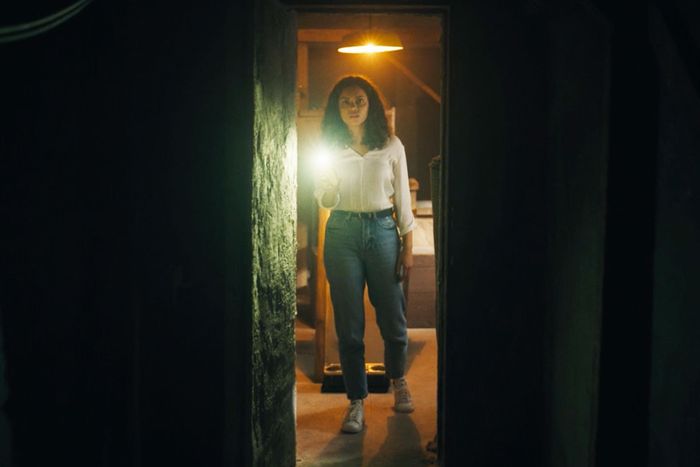
Characters in horror movies donÔÇÖt have to make terrible decisions, but terrible decisions are a reliable source of scares. Power out at the abandoned building? Go in anyway. Blood dripping down the walls of your obviously haunted new home? Stay put; the housing marketÔÇÖs a mess. Hear the sound of someone getting murdered out in the woods? Wander in that direction while yelling ÔÇ£Hello?ÔÇØ ÔÇö whatÔÇÖs the worst that can happen? These conventions are so ingrained in the genre that it feels like a challenge whenever a character actually does know better ÔÇö like Tess Marshall (Georgina Campbell), the heroine of Barbarian. When Tess ends up having to share a double-booked Detroit Airbnb with a stranger named Keith, she asks him to pull up his reservation info, goes through his stuff in the bathroom, takes a picture of his ID, and opts not to drink the tea he offers her. ÔÇ£Do I look like IÔÇÖm some kind of monster?ÔÇØ he protests, which is funny because heÔÇÖs played by murder twink extraordinaire Bill Skarsg├Ñrd.
Keith, it turns out, is a red herring, and the real dread starts when Tess accidentally locks herself in the basement and, while poking around looking for a way out, finds a rope protruding from the wall that, when pulled, opens a hidden door on a wall that looked like solid concrete. Tess takes a look at the yawning blackness revealed behind it, lets out a very reasonable ÔÇ£Nope,ÔÇØ and settles herself on the other side of the room to wait for help. Barbarian ÔÇö which, in a testament to changing release models, has made its arrival on HBO Max just 45 days after kicking off a successful run in theaters ÔÇö is a horror flick, and you know that Tess is going to go into that secret passage sooner rather than later. But one of the chief pleasures of the movie, which was written and directed by comedian Zach Cregger, is the way that it tries to avoid that ÔÇ£You idiotÔÇØ sensation that feels almost inevitable in mainstream horror.
Tess is hardly an idiot, and when she does give in to her curiosity and venture into that dark hallway, she gets as far as a windowless room containing a stained mattress, a fluorescent bulb, and an old camcorder, and after that sight, sheÔÇÖs ready to flee the house entirely. ItÔÇÖs Keith who pulls her back and goes down into the basement to see for himself and doesnÔÇÖt come back up, which leads to the best scene in the movie ÔÇö one in which a character makes a bad call, not because she doesnÔÇÖt know any better but because she feels she has a moral obligation to try to help. Because, it turns out, there is both a secret passage in the basement and a secret passage inside the secret passage: a staircase that looks like it was carved into the bedrock and leads into the dark, a discovery so ominous that it verges on comical. Standing at the top of that second set of stairs, which look like they could lead down into hell itself, and shining her feeble phone flashlight into the depths, Tess calls out for the missing man, hoping he doesnÔÇÖt answer.
When he does, screaming for help, she allows herself one glance back toward the exit ÔÇö where the afternoon sun is still streaming in through windows just out of the frame ÔÇö before heading down. The effectiveness of the sequence has everything to do with Tess knowing that sheÔÇÖs almost certainly headed toward something awful, but, because sheÔÇÖs a good person, and believing that she has no choice, that she canÔÇÖt just leave Keith to whatever grim fate has befallen him. Barbarian insists you wallow in the fear the character is feeling as she steps down into the gloom, only able to see a few feet in front of her and confronted with more and more forbidden sights in that limited bubble. While Campbell plays the character as trembling on the verge of hysteria, Cregger emphasizes her terror by scoring the scene to the sounds of TessÔÇÖs pounding heart and her stuttering breaths.
When she screams for Keith, her voice cracking and edged with tears, itÔÇÖs not the cry of someone destined to become slasher fodder but that of a woman who, for once, would actually like to be told sheÔÇÖs overreacting. ItÔÇÖs a great scene, one that the movie restages with another character later for more comedic ends, and itÔÇÖs also a reminder that not everyone in a horror movie has to drift obliviously toward seemingly certain doom. It can be just as frightening for them to drift toward seemingly certain doom while fully aware of what theyÔÇÖre doing.


